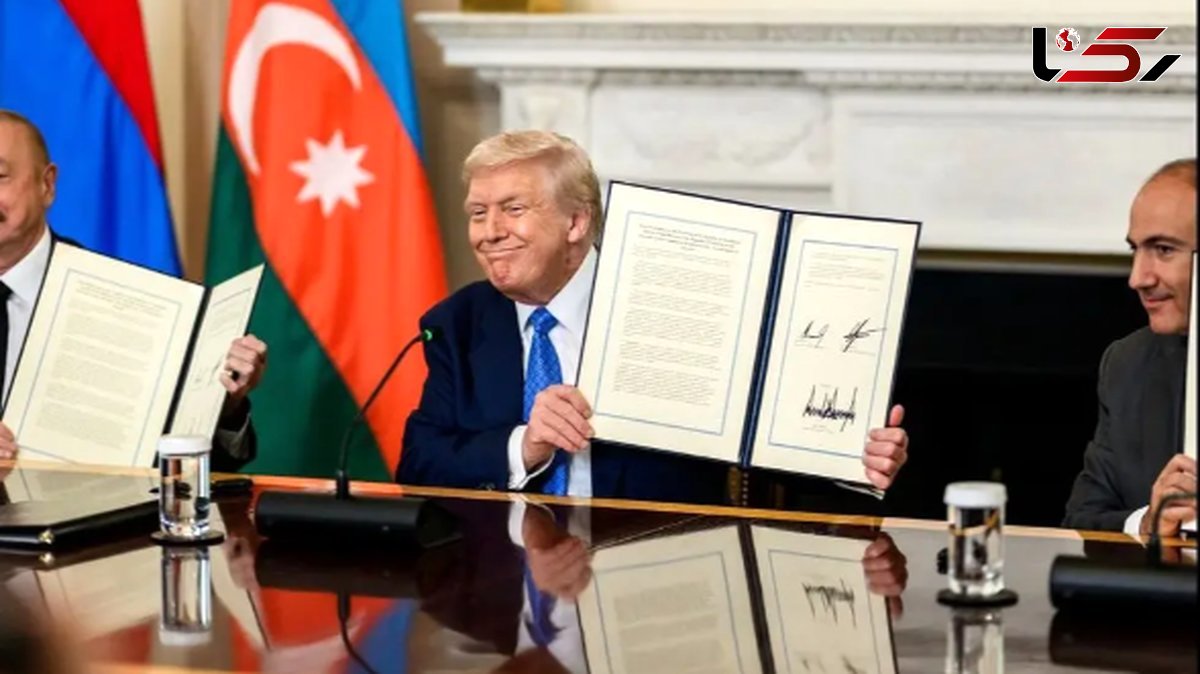The Caucasus in Flames: From Showpiece Agreement to Unresolved Tensions
Why is Iran the Main Obstacle to the Realization of the “Trump Corridor”?
Rokna Political Desk: Recent diplomatic moves between Armenia and Azerbaijan, culminating in the unveiling of a peace agreement at the White House, appear more a reflection of Baku’s military victory than of genuine reconciliation. Meanwhile, the U.S.-backed corridor project has heightened sensitivities in both Russia and Iran, challenging prospects for lasting peace in the South Caucasus.


Eldar Mamedov, Senior International Affairs Expert at the Quincy Institute
According to Rokna, citing Responsible Statecraft, recent intensive diplomatic activity between Armenia and the Republic of Azerbaijan—peaking with the presentation of a draft peace agreement at the White House—has been heralded as a historic milestone in the peace process of the South Caucasus. Yet behind the celebratory rhetoric lies a more complex reality: a reality in which narratives of victory act as a thin veil over unresolved tensions. In this environment, it is still military power, not genuine and sustainable compromise, that sets the rules of the game.
Showpiece Diplomacy and Field Realities: Why Peace in the Caucasus Remains Elusive
A day before the August 8 meeting with Nikol Pashinyan, Prime Minister of Armenia, and Ilham Aliyev, President of Azerbaijan, U.S. President Donald Trump boasted on his Truth Social platform about a “formal peace signing ceremony.” The reality, however, proved far more modest: the outcome was limited to a seven-point “joint declaration,” only four of which addressed the actual issues of the conflict. The remainder consisted of vague peace-loving platitudes and exaggerated praise of Trump’s mediating role.
Most importantly, the declaration was temporary and non-binding, as it was not signed by the heads of state but merely initialed by the foreign ministers of both sides. The subsequent publication of the full text made it evident that this “agreement” was nothing more than a reiteration of longstanding principles: a mix of provisions from the 1975 Helsinki Final Act—respect for borders, sovereignty, and territorial integrity—together with references to the 1991 Alma-Ata Declaration that recognized the dissolution of the Soviet Union and the establishment of the Commonwealth of Independent States. These vague and repetitive references clearly reveal that serious obstacles remain in the path of a genuine and durable peace treaty.
The draft agreement’s emphasis on “non-interference in internal affairs” carries little practical meaning, as Baku continues to insist on the removal of any mention of “Nagorno-Karabakh” from Armenia’s constitution. This is the very territory that triggered two bloody wars in the 1990s and in 2020, and which ultimately ended with Azerbaijan’s military victory, forced annexation, and the displacement of more than 100,000 indigenous Armenians in 2023. The exclusion of such a crucial issue from the agreement exposes the deep rift between international diplomatic display and the harsh realities on the ground.
For Nikol Pashinyan, this demand has become a severe political dilemma. He faces intense public pressure, as much of Armenian society views his performance as nothing short of “humiliating capitulation” to Baku. The Armenian prime minister, now an intensely controversial figure, is also entangled in exhausting conflicts with the influential Armenian diaspora and the Armenian Apostolic Church.
Pashinyan is forced to tread with utmost caution until the parliamentary elections of 2026. Any attempt to amend the constitution before then would require a divisive referendum—one that could inflame the political climate and further endanger his already precarious position. On the other side, President Aliyev, whose primary goal is to consolidate Azerbaijan’s military gains and enforce Baku’s victory narrative, is unlikely to tolerate such delays or considerations for long.
Why Azerbaijan Refuses Territorial Trade-Offs
Territorial exchange may appear a solution on paper, but in reality Yerevan holds no advantage in such an equation. Unlike Baku, Armenia has no enclaves situated inside Azerbaijani territory to offer in return. This imbalance leaves Azerbaijan with little incentive to relinquish its tactical advantages, ensuring that both military superiority and territorial leverage remain firmly in Baku’s hands.
Such leverage is not only a bargaining tool at the negotiating table but also a potential trump card in any future confrontation, one that could decisively tilt the balance in Azerbaijan’s favor. This reality underscores the fundamental flaw of the so-called “peace agreement”: rather than reflecting a balanced compromise, it embodies the triumph of Azerbaijan’s military victory. Having secured its battlefield achievements, Baku sees no necessity to offer meaningful concessions.
History warns clearly that military victory should never be mistaken for lasting peace. Armenia’s short-lived victory in 1994 quickly reversed, demonstrating just how fluid and fragile the balance of power in the Caucasus truly is. Azerbaijan today enjoys significant structural advantages—larger territory, greater population, and abundant natural resources. Yet present dominance offers no guarantee for the future, as shifts in regional alliances or domestic upheavals could rapidly reshape the balance. The core danger lies precisely here: the current agreement represents not genuine reconciliation but rather a “peace imposed by the victor.” Such a settlement neither heals past wounds nor lays the foundations for sustainable coexistence. Instead, it buries accumulated grievances under the surface, sowing the seeds of future conflict.
This reality explains why Ilham Aliyev continues to adhere to maximalist positions. He seeks to transform Azerbaijan’s current advantage into a mechanism for permanently eliminating any possibility of what Baku calls “Armenian revanchism.” This strategy is clearly reflected in Article 8 of the peace agreement, a broadly worded clause mandating the fight against “separatism” in all its forms.
This interpretation serves two key objectives: first, to permanently close the door on any Armenian territorial claims over Nagorno-Karabakh; and second, to deny in practice the right of return for the displaced Armenian population of the region. Within this framework, the forced displacement of 2023 was not a mere temporary military maneuver but a calculated effort to create “irreversible facts on the ground.”
The Security Puzzle of the Peace Corridor: U.S. Troops on Armenia’s Borders?
These local tensions unfold against a far more intricate geopolitical backdrop, where the rivalry of great powers does not resolve the crisis but rather risks fueling it further. Washington’s mediation has undoubtedly weakened Russia’s traditional influence in the South Caucasus, but it also confronts the United States with the very dilemma that ensnared the Kremlin for decades: “maintaining a fragile balance between Baku and Yerevan.”
So far, the U.S. has succeeded in securing both parties’ agreement to establish the “Trump Path for Peace and International Prosperity,” a U.S.-backed transit route designed to connect Azerbaijan through Armenian territory to Nakhchivan and ultimately to Turkey. Although presented as a vital economic artery and formally placed under Armenian jurisdiction, fundamental questions remain unanswered: Which body will guarantee the security of this route? Will U.S. troops or private contractors be deployed at checkpoints? And most crucially, what assurances exist for the preservation of Armenian sovereignty, when Baku insists on “unimpeded passage”—a phrase that in practice could mean the withdrawal of real Armenian control over part of its own territory?
The Kremlin’s cool and calculated response to the U.S.-mediated agreement is less an acceptance than a deliberate strategy to preserve cordial ties with Donald Trump. More importantly, it reflects Moscow’s recognition that by ceding initiative in the South Caucasus to Washington, the United States has now inherited both the potential rewards and the heavy risks of this volatile region. Yet the key question remains unanswered: how far is Washington willing to go—and how much is it prepared to spend—to stabilize a region located 6,000 miles from its borders?
Despite all speculation about Moscow’s retreat, Russia maintains deep economic and infrastructural ties with Armenia and is likely to support pro-Russian factions in the 2026 parliamentary elections. Furthermore, the permanent presence of Russian border guards along Armenia’s frontier with Iran adds yet another layer of complexity—one that any U.S.-backed corridor must take into account in its security and political calculations.
Iran’s Red Line: Why U.S. Presence on Its Northern Borders Is Unacceptable
Among regional players, Iran has voiced the sharpest criticism of the proposed “Trump Path for Peace and International Prosperity.” Although President Masoud Pezeshkian adopted a conciliatory tone, he nonetheless issued a clear warning that U.S. presence along Iran’s borders would be “problematic.” Meanwhile, Ali Akbar Velayati, senior foreign policy adviser to the Supreme Leader, took an even tougher stance, pledging that Tehran, regardless of Moscow’s position, would oppose the “Trump Path.”
Iran perceives any U.S. presence near its borders as a provocative act and a direct threat. From this perspective, Tehran could emerge as one of the most serious disruptors of the agreement’s implementation.
The South Caucasus has witnessed numerous agreements collapse despite being hailed as “historic” at the time of signing, only to prove short-lived in practice. If the recent agreement is to avoid such a fate, it must move beyond symbolism and address the unresolved roots of the conflict: from territorial disputes and constitutional reforms to the rights of displaced populations. Without addressing these core issues, the agreement will be nothing more than a temporary ceasefire—an interlude in a conflict that has persisted without sustainable resolution for decades.
Real peace requires more than diplomatic spectacle and grandiose declarations. It demands difficult compromises and costly decisions that have so far been absent. Until such compromises are reached, the promise of stability in the South Caucasus will remain little more than a mirage.
Great article! Things could change radically when Israel attacks Iran again, and the participation of Iran's neighbors in such an attack becomes clear. The bombing of the SOCAR installations in Ukraine by Russia is sending a clear message to Baku.
It would be interesting to have a diplomatic Iranian think tank in Armenia.
-Yerevan, Armenia